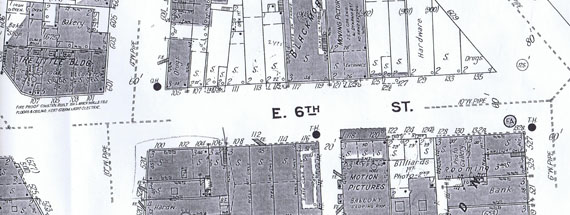
Sanborn Fire Insurance Map, 1923. We were hoping to be able to get this section of town from the 1897 or 1903 Sanborn Fire Insurance Map that possibly would show a floor plan of sorts for the Grand Opera House but we couldn't find a workable URL for that map. The opera house shown on the above map would have been street address 108-116.
". . . .Our subject [William T. Burton]was one of the organizers of the New Grand Opera House Company, which was incorporated in 1893. with William T. Burton as president: Dr. W. Y. Bailey. secretary: S. J. Cripps treasurer; and J. M. Morris, manager. They erected on Sixth Street what was at that time the finest theatre in Eastern Ohio, the building being 92 by 79 feet in dimensions, three stories high and with a capacity for accommodating 1.000 people.. ." History of Columbiana County And Representative Citizens. Edited and Compiled by William B. McCord , Biographical Publishing Co. Chicago, Illinois (1905) p582
Some views of the exterior from different perspectives.

A aerial view taken during the American Theater fire May , 1950. The Grand Opera House is to the right , across the alley from the burring American Theater. It is dark building nestled in between the theater, the building with the smoke pouring form it, and the Thompson Building, the white looking building in the picture. This particular picture gives a good view of the sheer size of the Opera House.
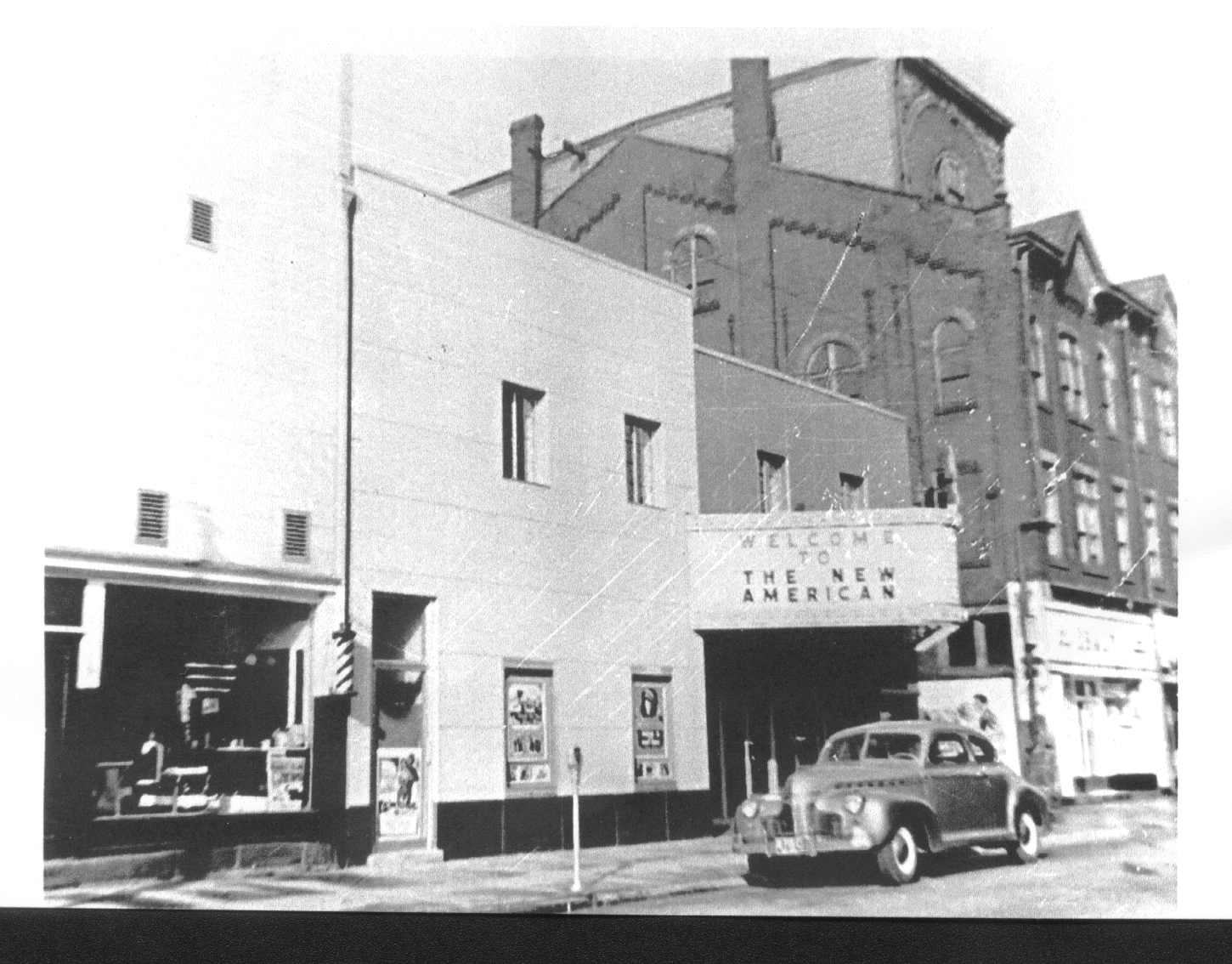
Across the alley from the "new" American Theater in the picture above you can see the Grand Opera House. The first floor of that building at this point in time is Isaly's (Bricker's) and beside it is the Outdoor Army and Navy Store. After the Diamond Fire of 1968 the top floors were removed as a result of fire, water, smoke damage.
Here is another view of the Grand Opera House from the opposite direction around 1955.
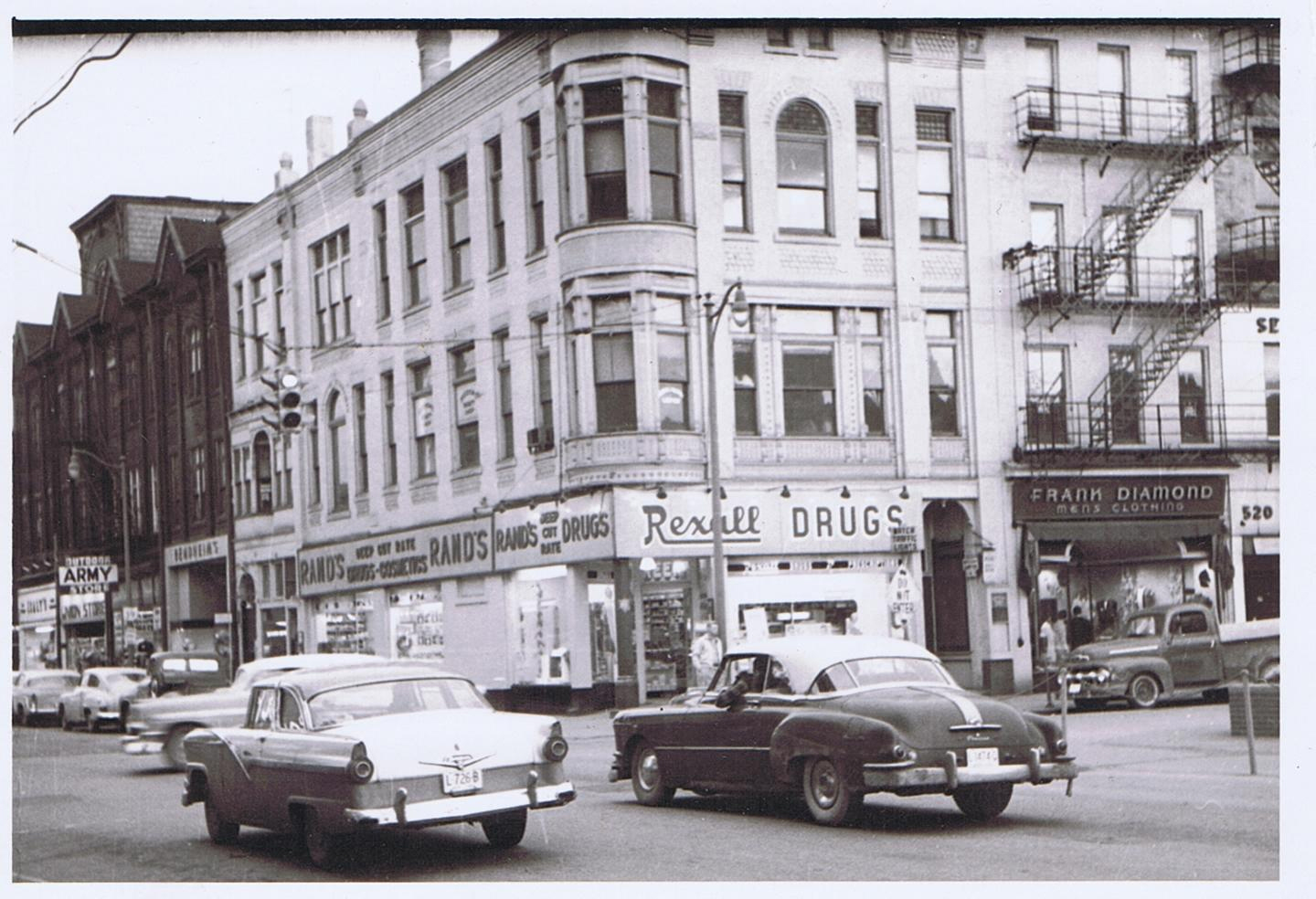
In the above picture it is the last building at the far left of the picture.
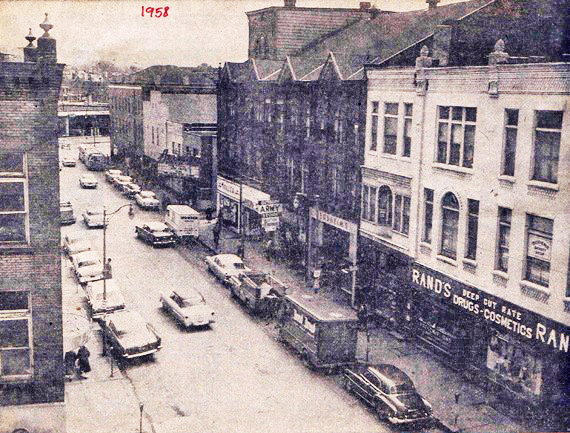
East Liverpool, Ohio
GRAND OPERA HOUSE
Seating capacity, 1,200. Upholstered furniture.
Stage, 70 by 30, 44 ft. in the clear from floor of stage.
No grooves. Electric. car line passes main entrance.
A population of twenty thousand to draw from.
TO OPEN AUG. 28, 1893
Secure dates for season 1803-94 by addressing JAMES E. ORR, Manager.
Care of A. C. Wolfe, Wellsville, Ohio.
The New York Dramatic Mirror, Page 17, October 21, 1893:
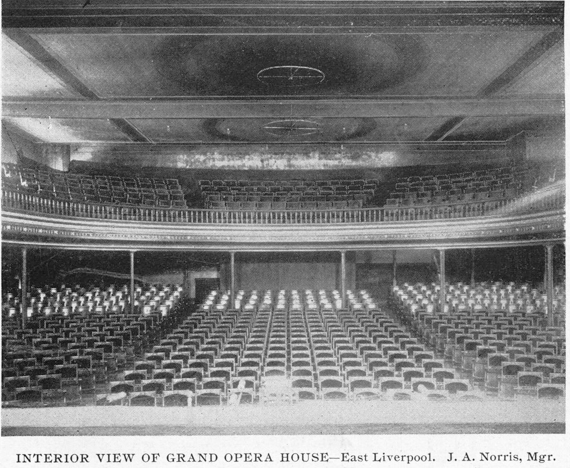
Interior of the Grand Opera House. [This picture would have shown the interior as it looked between opening in 1893 and the conversion to a skating rink in 1905 ELHS Webmaster.
Interior Picture from the Booklet: East Liverpool Ohio, The Pottery Center of America, 1799-1899.
Additional Information:
In addition to these outdoor facilities, East Liverpool had an abundance of indoor entertainment. In August of 1893 a third opera house, the Grand, was opened in the "Crockery City." Like its competitors, the new "house" offered patrons a variety of dramatic, comic, and musical plays. The opening of the Grand Opera House, featuring the noted actor Thomas Keane performing Richard III, was attended by Governor William McKinley as a guest of Mr. and Mrs. John N. Taylor. Before the performance, McKinley praised the city on its fine new opera house. For the next five years the Grand offered residents a rich variety of plays; in May of 1898 it was converted to a theatre for minstrel and vaudeville shows. In 1905 it was remodeled into a roller skating rink. On 21 November 1904 the Ceramic Theatre on Fourth Street was opened to the public with a presentation of "Wang" starring DeWolf Hopper and a cast of seventy supporting performers. The opening was considered a "brilliant social affair." The new theatre, which was the second largest in Ohio, had a seating capacity of two thousand and was rated as one of the finest between New York and Chicago. It consistently attracted some of the best "shows" in the nation and many of the period's most successful plays originated at the Ceramic Theatre. The interior of the $150,000 theatre was considered "elegant" and the "acoustics were perfect."
The fact that both the Grand Opera House and the Ceramic Theatre were eventually converted to more mundane purposes was a sign of the times and reflects the movement toward a mass technological culture. Other evidence of the shift to new forms of entertainment because of new technology is provided by the fact that many other theatres were constructed for strictly vaudeville performances and moving picture shows. SOURCE: The City of Hills and Kilns, Life and Work in East Liverpool, Ohio. William C. Gates, Jr. East Liverpool Historical Society, (1985) page 245.
Long Roller Skating Craze.- Roller skating became a craze in 1883 and continued with undiminished interest until 1890. The Fifth Street and the Jumbo rink on Fourth Street were the scenes of this activity which thousands, old and young, enjoyed during this interim. Races were frequent and several outside skaters were brought into the city to contest with local participants or show their own skill. These included John J. Bell, of Cleveland, William Borst, of New York City, Jesse Birkett, of Bellaire, who later became a famed American league baseball player and John Hankey, of Canton. The East Liverpool star skaters included John Reark, "Billy" Bott, Samuel Wallace, Owen Cannon, Thomas Croxall, William Delaney, Lyman Rinehart, "Fred" Anderson, Horace Woolmaker, Charles Reak and W. A. Calhoun. A feature of these days was the remarkable development of Thomas Worcester, a pioneer potter. She showed such adeptness in her work that she was given the same training as that ascribed to the male skaters. Thus it came about that she was never defeated.
The sport was somewhat revived a quarter of a century later when roller skating was indulged in for a period on the Sixth Street Rink and at Rock Springs Park, Chester, W. Va.
History of Columbiana County, Ohio - Harold B. Barth, CHAPTER XX,SPORTS AND RECREATIONS,Historical Publishing Company 1926.
[The Sixth Street Rink referred to is probably the former Grand Opera House that was converted into a skating rink in 1905. ELHS Webmaster]
The End of the Former Opera House.
The "Diamond" again suffered a major blaze March 3rd, 1968. This fire, one of the worst in the city's history,. . . The fire broke out on the second floor of the four story Siff Shoe Store Building. The building was located on Market St. at Diamond Alley. The fire quickly reached the roof and quickly spread across the rooftops of the adjoining buildings. The flames traveled all the way to Crook Alley before being stopped. The Siff Building was a total loss and had to be razed. . . The other buildings received lesser amounts of damage. The Opera Building on E. Sixth St. had the top two floors removed after the fire. This building was occupied by Isaly's restaurant, the Outdoor Army Store and Bendhiem Shoes. . .Excerpt from Chapter Ten, Great Fires, the unfinished manuscript of Gary Cornell, retired East Liverpool Fire Department firefighter and Fire Department historian.

From the 1923 Sanborn Fire Insurance map. By 1968 Summit Lane had been changed to Diamond Alley. It is easy to see how this fire spread across roof tops to include the former Opera House.
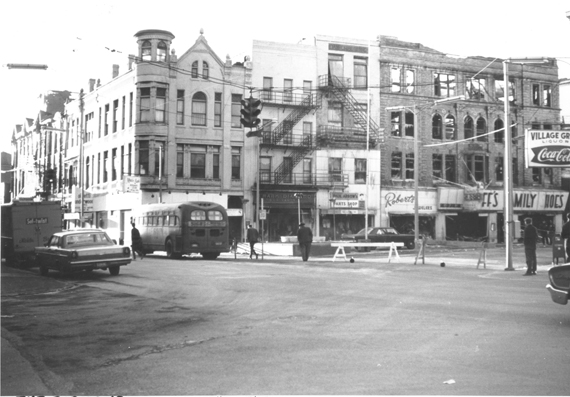
Siff Shore Store, far right, fire started there.
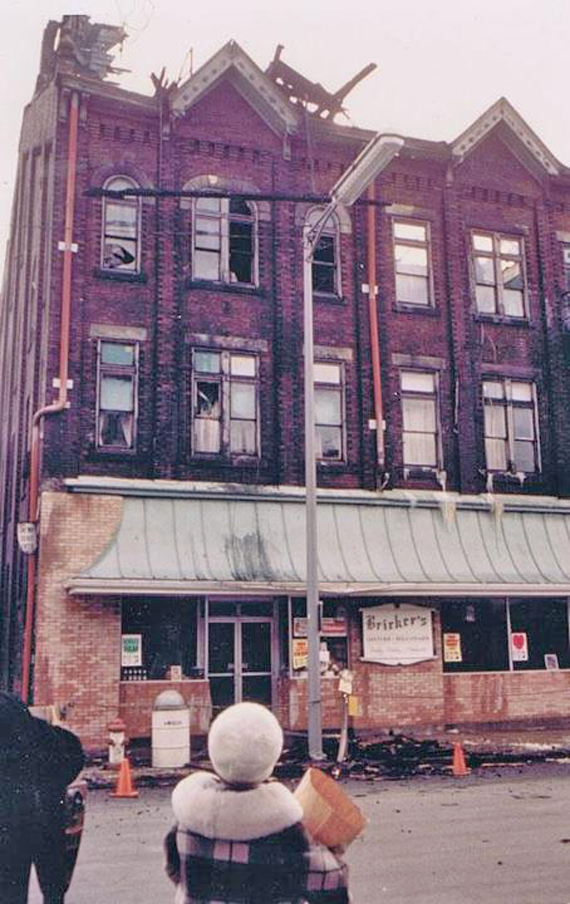
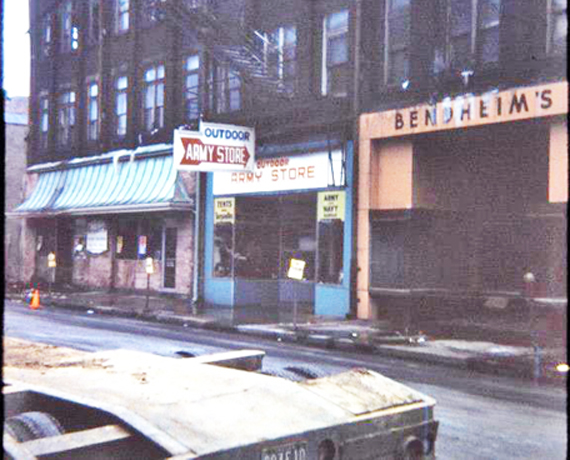
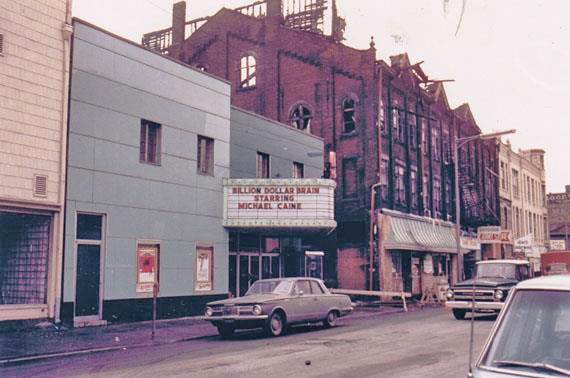
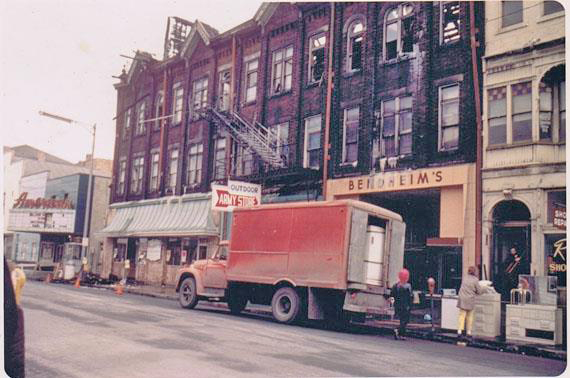
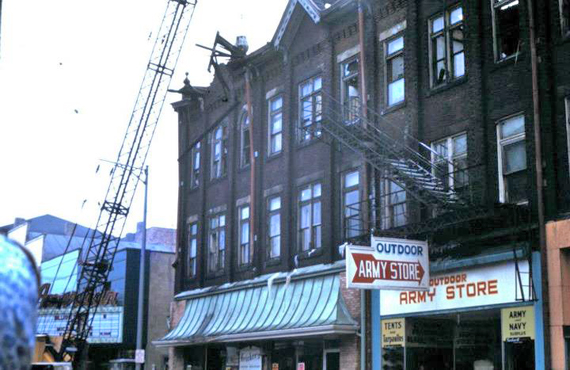
What it look like after it was removed..
This site is the property of the East Liverpool Historical Society.
Regular linking, i.e. providing the URL of the East Liverpool Historical Society web site for viewers to click on and be taken to the East Liverpool Historical Society entry portal or to any specific article on the website is legally permitted.
Hyperlinking, or as it is also called framing, without permission is not permitted.
Legally speaking framing is still in a murky area of the law
though there have been court cases in which framing has been seen as violation of copyright law. Many cases that were taken to court ended up settling out-of-court with the one doing the framing agreeing to cease framing and to just use a regular link to the other site.
The East Liverpool Historical Society pays fees to keep their site online. A person framing the Society site is effectively presenting the entire East Liverpool Historical Society web site as his own site and doing it at no cost to himself, i.e. stealing the site.
The East Liverpool Historical Society reserves the right to charge such an individual a fee for the use of the Society’s material.